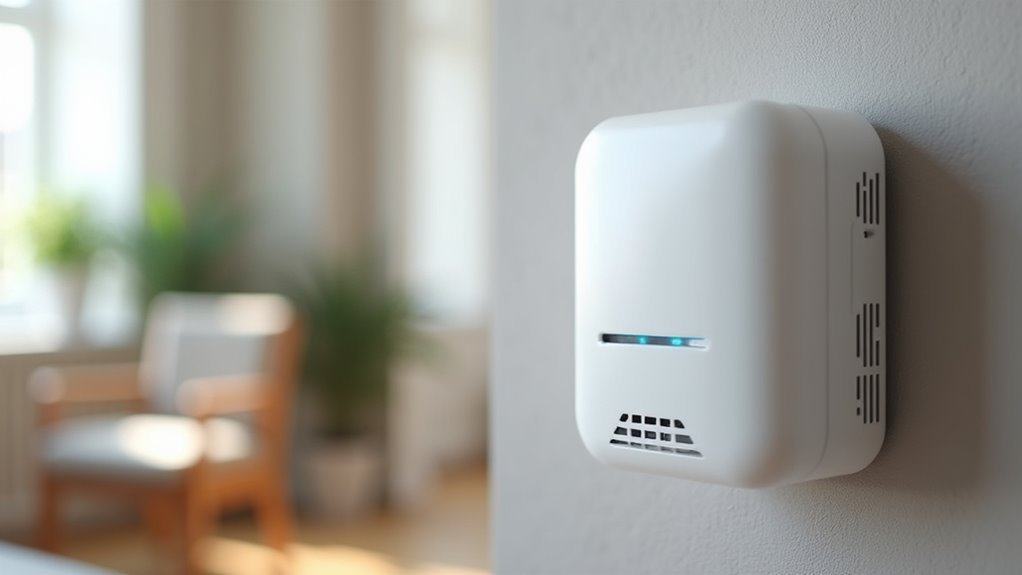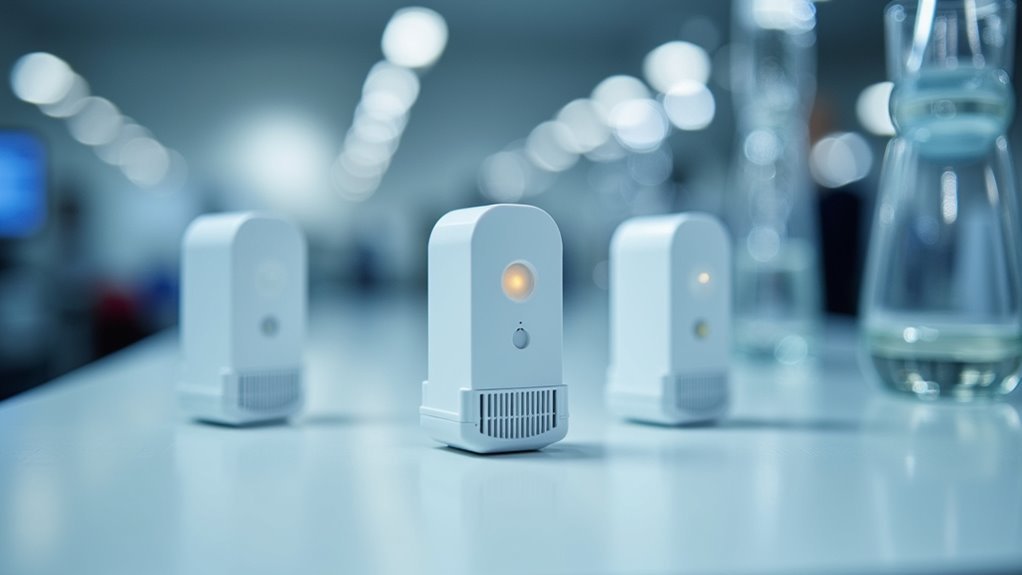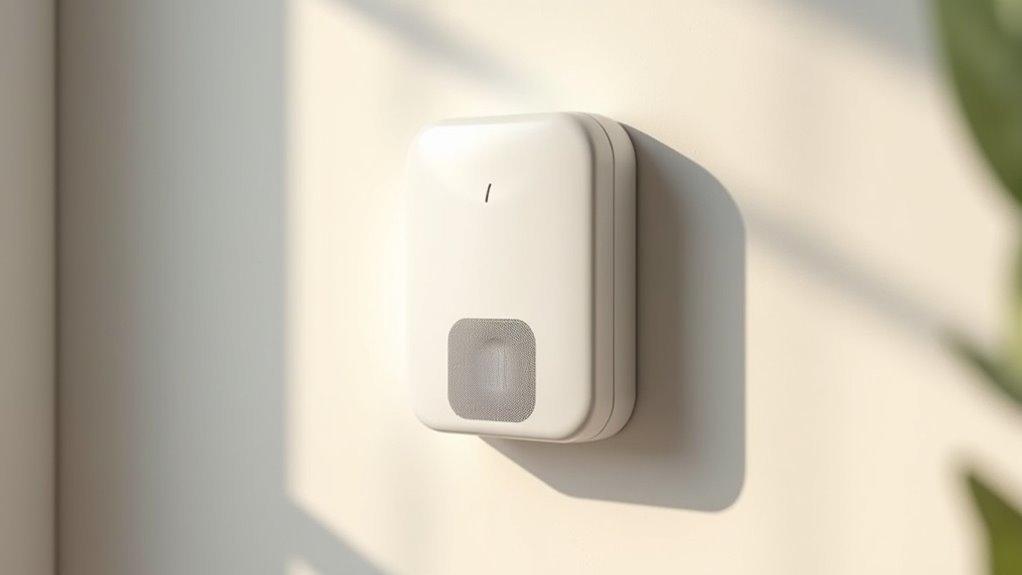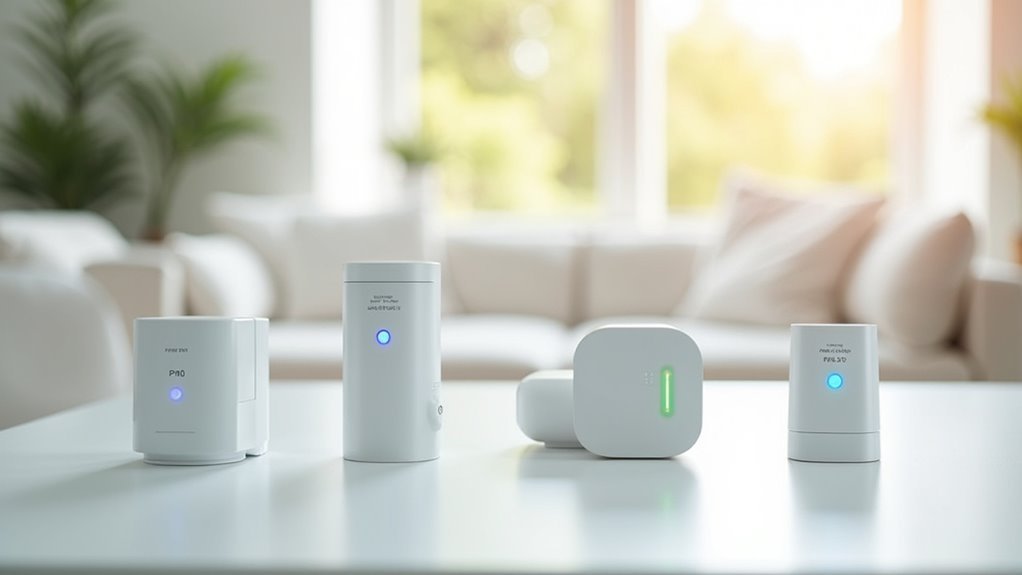You’re breathing indoor air that’s potentially filled with PM10 particles—dust, pollen, and other pollutants that can impact your health without you even knowing it. While your smart home monitors everything from temperature to security, it’s likely missing this vital air quality component. The right WiFi PM10 sensor won’t just alert you to problems; it’ll automatically trigger your HVAC system and air purifiers to respond before conditions worsen.
Essential Features to Consider in WiFi PM10 Sensors

When selecting a WiFi PM10 sensor for your smart home, you’ll want to prioritize accuracy as your primary consideration. Look for sensors offering ±15% accuracy ratings to guarantee reliable health assessments.
Real-time data capabilities are essential—choose models that refresh every 1-2 seconds for prompt air quality monitoring.
Choose sensors with 1-2 second refresh rates to ensure immediate detection of PM10 changes in your indoor environment.
Important connectivity features include 2.4 GHz WiFi compatibility, enabling seamless integration with your existing smart home ecosystem. You’ll need thorough data management with at least 13 days of historical tracking for trend analysis.
Don’t overlook user-friendly interfaces featuring clear displays and mobile app integration. These sensors should provide convenient monitoring and instant alerts about PM10 levels, making air quality management effortless in your connected home environment.
Top-Rated WiFi PM10 Sensors for Smart Home Integration
Several standout WiFi PM10 sensors have earned top ratings for their seamless smart home integration capabilities.
These indoor air quality monitors excel at connecting with existing automation systems while providing accurate real-time monitoring of particulate matter levels.
Leading models that deliver exceptional smart home integration include:
- Airthings View Plus – Features thorough PM10 tracking with radon detection, plus native integrations with Alexa, Google Assistant, and IFTTT for automated responses.
- GoveeLife Smart Air Quality Monitor – Offers multi-parameter monitoring including PM10, temperature, and humidity with customizable app alerts and smart device connectivity.
- IQAir AirVisual Pro – Provides professional-grade accuracy with advanced API capabilities for deep smart home system integration.
You’ll find these WiFi PM10 sensors automatically trigger air purifiers and ventilation systems based on detected pollution levels.
Accuracy and Calibration Requirements for PM10 Monitoring

While smart home integration gets you connected, accurate PM10 measurements depend entirely on proper sensor calibration and maintenance.
You’ll need to understand that PM10 sensors measuring particulate matter require regular calibration checks to maintain their advertised ±10-15% precision range. Without proper calibration, your air quality monitoring can show significant discrepancies in pollution levels, making your data unreliable.
Most manufacturers recommend manual calibration every few months for ideal performance in smart homes.
Advanced sensors using laser scattering technology offer improved accuracy, but they’re not exempt from calibration requirements. Environmental factors can affect readings, so you should follow manufacturer guidelines strictly.
Smart Home Connectivity and Automation Capabilities
Beyond basic air quality readings, WiFi PM10 sensors transform your smart home into an intelligent air management system that responds automatically to pollution changes.
These sensors seamlessly connect to your existing smart home ecosystem, enabling thorough monitoring and control from your smartphone or home automation hub.
Your WiFi-enabled sensors offer three key automation capabilities:
- Automatic HVAC integration – Sensors communicate directly with air purifiers and ventilation systems, adjusting filtration levels based on real-time PM10 readings.
- Proactive alert systems – Receive instant notifications when pollutant thresholds are exceeded, enabling immediate response to air quality threats.
- Voice assistant compatibility – Query current air quality data and control connected devices through Amazon Alexa or Google Assistant commands.
This automation guarantees your home maintains ideal air quality without constant manual intervention.
Installation and Placement Guidelines for Optimal Performance

You’ll get the most accurate PM10 readings when you position your sensor in well-ventilated areas at breathing height, typically 3 to 6 feet above ground.
Keep it away from pollution sources like kitchens and heating appliances, and make sure it’s mounted in open spaces rather than near walls or corners for ideal airflow.
Your WiFi connection needs to be strong and stable at the installation location to maintain consistent data transmission and remote monitoring capabilities.
Optimal Sensor Placement
Since proper placement directly impacts measurement accuracy, you’ll want to position your WiFi PM10 sensor in well-ventilated areas that aren’t influenced by direct pollution sources like kitchens, bathrooms, or entry points where outdoor air rushes in.
For ideal sensor placement of your indoor air quality monitor, consider these essential factors:
- Height positioning – Mount PM10 sensors between 3-6 feet above ground level to capture air quality data that reflects what occupants actually breathe.
- Environmental conditions – Avoid areas with excessive humidity or temperature fluctuations that compromise sensor reliability and accuracy.
- Protection from elements – Keep your monitor away from direct sunlight and heat sources by choosing shaded locations.
Regular maintenance prevents dust buildup that interferes with your device’s ability to monitor air quality effectively.
WiFi Connectivity Requirements
Most WiFi PM10 sensors rely on a stable 2.4 GHz wireless connection to transmit air quality data to your smartphone or home automation system. You’ll need to guarantee your sensors maintain strong connectivity for reliable monitoring and accurate readings.
| Requirement | Specification | Impact |
|---|---|---|
| Network Band | 2.4 GHz WiFi | Essential for data transmission |
| Signal Range | Within router range | Prevents connectivity drops |
| Firmware Updates | Regular updates | Improves performance accuracy |
Position your sensors within your WiFi network’s coverage area to avoid connection interruptions that compromise data reporting. Distance from your router directly affects signal strength, so you’ll want to test connectivity before finalizing placement. Regular firmware updates enhance your sensors’ functionality and address potential connectivity issues, guaranteeing consistent monitoring performance throughout your smart home system.
Real-Time Data Monitoring and Mobile App Functionality
You’ll want a WiFi PM10 sensor that delivers live particulate tracking straight to your smartphone, giving you instant visibility into your indoor air quality.
Modern sensors excel at sending immediate mobile alerts when PM10 levels spike, so you can take action before poor air quality affects your health.
Look for models that include robust data export features, allowing you to download and analyze your air quality trends over weeks or months.
Live PM10 Tracking
Real-time monitoring transforms how you understand and respond to your home’s air quality. Live PM10 tracking delivers instant updates on particulate matter concentrations, empowering you to make informed decisions about your indoor environment.
WiFi-enabled sensors seamlessly connect to your smartphone, providing extensive mobile app functionality that puts critical air quality data at your fingertips.
Modern PM10 sensors enhance health management through:
- Instant alerts – Customizable notifications warn you when PM10 levels exceed safe thresholds
- Visual dashboards – User-friendly interfaces display clear air quality scores and trend analytics
- Historical analysis – Data export capabilities let you track patterns and share information with healthcare providers
This real-time data access enables proactive responses to air quality changes, protecting your family’s respiratory health while maintaining ideal indoor conditions.
Mobile Alert Systems
When PM10 levels spike unexpectedly, mobile alert systems instantly notify you through push notifications, ensuring you’re never caught off guard by deteriorating air quality.
WiFi PM10 sensors integrate seamlessly with smartphone apps, delivering real-time notifications whenever pollution exceeds your predefined thresholds. You’ll receive immediate alerts prompting actions like activating air purifiers or adjusting ventilation systems.
These mobile apps provide extensive air quality data through user-friendly interfaces displaying current readings and detailed historical trends. You can analyze patterns over days, weeks, or months to understand your indoor environment better.
Customizable alert settings let you tailor notifications to your specific needs and sensitivity levels. Remote monitoring capabilities mean you’ll stay informed about your home’s air quality even when you’re away, enabling proactive management of your living environment.
Data Export Features
Most WiFi PM10 sensors include robust data export capabilities that transform your air quality measurements into actionable insights.
You’ll find these features essential for long-term monitoring and professional analysis of your smart home environment.
The data export functionality typically provides:
- CSV and Excel formats – Download extensive datasets containing timestamped PM10 readings for spreadsheet analysis
- Historical trend reports – Export weekly, monthly, or yearly summaries showing air quality patterns and anomalies
- Professional documentation – Generate formatted reports suitable for sharing with healthcare providers or environmental consultants
Your WiFi-connected sensor continuously captures real-time monitoring data, making it instantly available for export through the mobile app.
This capability proves invaluable when you need to demonstrate air quality improvements, track seasonal variations, or provide documentation for health-related concerns in your living space.
Budget Considerations and Value Comparison
Budget plays an essential role in selecting the right WiFi PM10 sensor for your smart home, with entry-level options starting around $50 that make air quality monitoring accessible without breaking the bank. However, budget-friendly models often sacrifice accuracy and reliability, so you’ll need to weigh immediate savings against long-term performance.
| Price Range | Features | Best For |
|---|---|---|
| $50-$100 | Basic monitoring, WiFi connectivity | Budget-conscious users |
| $100-$200 | Data logging, real-time alerts, better accuracy | Balanced performance needs |
| $200+ | Advanced smart home systems integration, automated adjustments | Premium automation setups |
When evaluating value, consider potential health benefits and reduced medical expenses from better air quality management. Higher-end sensors enable sophisticated automated adjustments to your HVAC and air purification systems.
Frequently Asked Questions
How Often Do Wifi PM10 Sensors Need Battery Replacement or Charging?
You’ll typically need to charge WiFi PM10 sensors every 2-4 weeks, depending on usage and model. Some plug-in versions don’t require charging, while battery-powered units need regular maintenance for peak performance.
Can These Sensors Detect Wildfire Smoke and Outdoor Pollution Sources Effectively?
You’ll find PM10 sensors detect wildfire smoke particles effectively since smoke contains significant PM10 matter. They’ll also identify outdoor pollution from traffic, industrial sources, and dust, though PM2.5 sensors provide better precision.
Do Wifi PM10 Sensors Work During Internet Outages or Power Failures?
Most WiFi PM10 sensors won’t work during internet outages since they rely on network connectivity for remote monitoring. However, they’ll continue collecting data locally if they have backup power or battery systems during electrical failures.
What Is the Typical Lifespan of a Wifi PM10 Sensor?
You’ll typically get 3-5 years from your WiFi PM10 sensor before needing replacement. The laser diode and fan components wear out first, while humidity and dust exposure can shorten the sensor’s overall operational lifespan considerably.
Are There Health Risks From Electromagnetic Radiation Emitted by These Devices?
WiFi PM10 sensors emit low-level radiofrequency radiation similar to other wireless devices. You’re exposed to minimal electromagnetic fields that’re well below safety limits established by regulatory agencies, so health risks are considered negligible for typical home use.





Leave a Reply